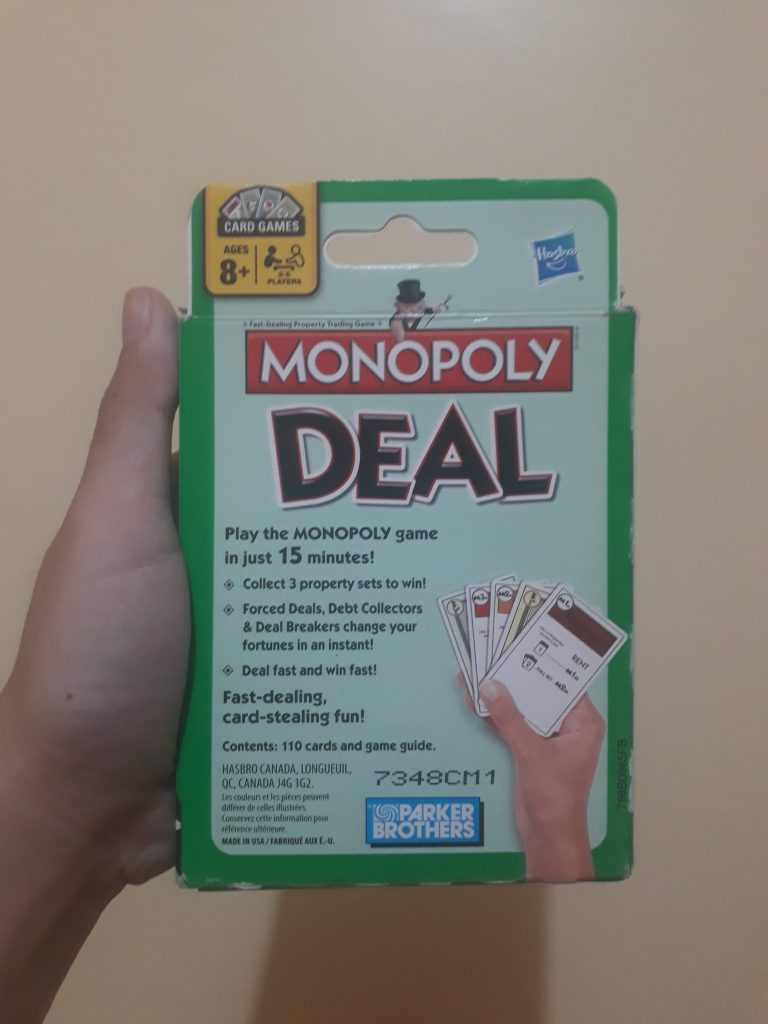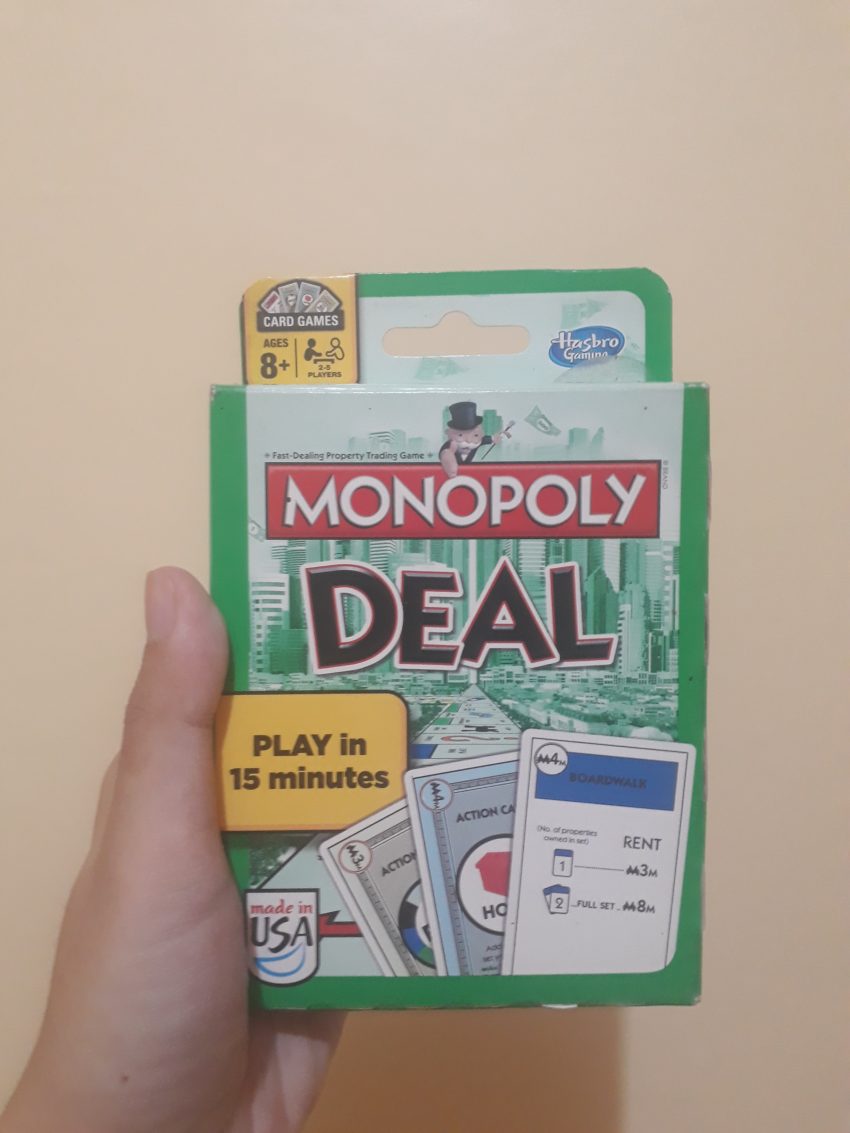On a daily basis, therapists analyze every toy they use to suit the goals and activities they have for their clients. The process becomes more automatic for us as we go along our practice. But before it has turned into a habit, we all went through the long road of dissecting everything about a toy. No pun intended.
I could not believe that almost a decade has passed since the first time I wrote a comprehensive toy analysis. Seeing my untouched stock pile of toys, I decided to do an OT version of toy unboxing and review. I present to you my OTPF-3 compliant Toy Analysis of Monopoly Deal.

I. PHYSICAL PROPERTIES
A. General Description
- Monopoly Deal is a card game that allows Monopoly to be played on-the-go. Players collect properties and steal from their opponents. First player to collect 3 full property sets of different colors wins. It costs 1 USD. But versions available in the Philippines can cost up to 3.5 USD or PHP 175. It is recommended to children ages 8 years old and up.
B. Packaging
- General Packaging: The game’s guide and 110 cards can be easily unpacked from its thin cardboard box.
- Portability: Monopoly Deal is portable. It can easily be carried or transported with or without the packaging.
- Containment and Storing: The packaging is reusable and stores the cards properly. However, it is prone to wear and tear. Once the original box is worn-out, the cards can be kept in another box or bundled together with a rubber band.
C. Individual Parts
- General Size of Toy Parts: The playing cards are approximately the same size of a regular ID or debit card.
- Cleaning: The cards can be easily cleaned using dry cloth. In extreme circumstances, lightly damped cloth can clean the stains.
- Toxic/ Non – toxic: Monopoly Deal is non-toxic. No hazards indicated.
- Choking Hazards: None.
- Durability: The cards are durable enough to withstand repetitive use. However, it is prone to wear and tear especially if a card is repeatedly folded, crumpled or wet.
- Safety of Parts: There are no possible dangers considering that it is a card game. The cards should be packed away properly after playing to avoid missing parts or scattered contents on the floor causing the child to step or slip on it.
- Risks for Misuse: None.
II. INTRINSIC PROPERTIES
A. Degree of Realism
The cards are of the same size as the common playing cards. The money cards are wider and shorter than the traditional Monopoly money bills but have the same colors. Compared to real money, the cards’ values are limited only to 1M, 2M, 3M, 4M, and 5M. Change is also not given. The houses and the hotels are drawn in the card unlike the miniature houses and hotels in the traditional Monopoly game.
Monopoly Deal can be used to explain the concept of collecting properties, charging rent, and receiving money to a child in a simple but fun way. However, it should be emphasized that it is a game and some of its rules are not accepted in real life like stealing or forced swapping of properties.
B. Degree of Structure
Monopoly Deal is highly structured. Each card has its own function. The rules are set that the quickest player to collect 3 differently-colored full property sets is the winner. Some rules can be modified or removed. The money cards can be used in pretend play. Games such as sorting the cards by use or type and matching the cards to form full sets can also be done.
C. Reactive or Non-reactive Nature
Monopoly Deal is non-reactive. The game starts after dealing 5 cards to each player from the shuffled deck. It is important to read the rules first. The flow becomes clearer once the game starts.
D. Motivational Value and Attractiveness
Monopoly Deal has a simpler design than the traditional Monopoly. This elicits curiosity and entices children ages 8 years old and up to play. But the rules are what can make it intimidating to them. Up to 3 cards can be played on each turn. Instructions written in the action cards should be followed.
Players should look out for Sly Deal, Deal Breaker, and Forced Deal. To cancel the effects of these cards, the players should use the Just Say No card. They should also be ready to pay rent and give birthday money. This game can be played in 15 minutes, the fast-paced dealing and stealing cards can motivate the children to play more rounds. However, consecutive losses can also be frustrating.
E. Play Value and Cost Effectiveness
The card game is played by at least two children with maximum of five players. Being a card version of Monopoly, it can tap the interest of other age groups. It is best suited for school-aged children.
The game needs to be played repeatedly for the rules to get clearer and so that the child can develop his or her own strategy. The card game is not easy to master. This may cause frustration and lost of interest. Despite being prone to wear and tear, Monopoly Deal can last repetitive use by multiple people.
F. Environmental Considerations during Play
The card game can be done in a table-top or on the floor. Due to its portability, it can be played both indoors and outdoors. Just make sure that it is a well-lit and ventilated environment.
G. Grading and Adaptation
- Upgrade: Five children will play. Instead of explaining the rules, the rule cards will be given to them. Each player needs to read the rules. They will discuss the rules with each other. They will set up the cards on their own. First to win 3 rounds is the Monopoly Champion.
- Downgrade: Only two players will play. The caregiver will read and explain the rules. A trial game can be done before the real 1st round. The cards are already set-up. Visual cues for the positions of the draw and play piles, bank pile, and property sets. The caregiver will be on stand-by to assist in counting, reading and explaining the effects of action cards they wish to use. An illustration of the game set-up can also be in the middle of the table so that everyone can monitor if their cards are in proper position.
- Adaptation: Sorting the cards by use, type, and color. Matching the cards to form full sets for each color.
H. Gender Appropriateness
Monopoly Deal can be played by all genders.
III. THERAPEUTIC PROPERTIES
A. Required Performance Skills
- Motor and Praxis skills: Aligns, stabilizes, positions, reaches, bends, grips, manipulates, coordinates, moves
- Process skills: Paces, attends, heeds, chooses, uses, handles, inquires, initiates, continues, sequences, terminates, searches, gathers, organizes, navigates, adjusts, accommodates, benefits
- Social Interaction skills: approaches, concludes, produces speech, gesticulates, speaks fluently, turns towards, looks, places self, touches, regulates, questions, replies, discloses, expresses emotions, disagrees, thanks, transitions, times response, times delay, takes turns, matches language, clarifies, acknowledges and encourages, heeds, accommodates, benefits
B. Required Body Functions
- Mental functions
- Higher – level cognitive: Judgment, concept formation, executive functions, cognitive flexibility, insight
- Attention – Sustained, shifting, and divided attention, concentration
- Memory – Short-term and working memory
- Perception – Auditory, visual, and tactile
- Thought- Logical and coherent thought
- Emotional- Regulation and range of emotions
- Experience of self and time- awareness of identity, body, and position
- Global Mental Functions
- Consciousness
- Orientation to self, place, and time
- Temperament and Personality- Openness to new experiences, self-control, self-expression, confidence, motivation, impulse control
- Sensory Functions
- Touch, Visual, Vestibular, Proprioreceptive, Hearing functions
- Neuromusculoskeletal and Movement – related Functions
- Range of motion, joint stability
- Voice and Speech Functions
C. Social Demands
The card game is usually played by children from middle and upper class families. The game is played with a partner or group. It can be with peers or siblings.
D. Levels of Play
- Cognitive Play: Games with rules
- Social Play: Competitive
E. Age-Appropriateness
Appropriate to at least 8 years old. But personally, I will give it to at least a 10-year old child or a teenager.
F. Versatility or Variety of Activities
- Sorting and categorization games
- Matching pictures to form full sets
- Teaching value of money
- Teaching personal finance- saving money, paying rent, business deals, rental property income

References:
Occupational therapy practice domain & process. (3rd ed.).(2014). Bethesda, MD: American Occupational Therapy Association.
OT140 Toy Analysis Outline for A.Y. 10-11 by RABdeGuzman, UPM-CAMP Department of Occupational Therapy


Wonderful work! That is the type of information that should be shared around the internet. Neda Robert Veta
hi, really good post, and an excellent understand! at least one for my bookmarking. Billye Fitz Merna